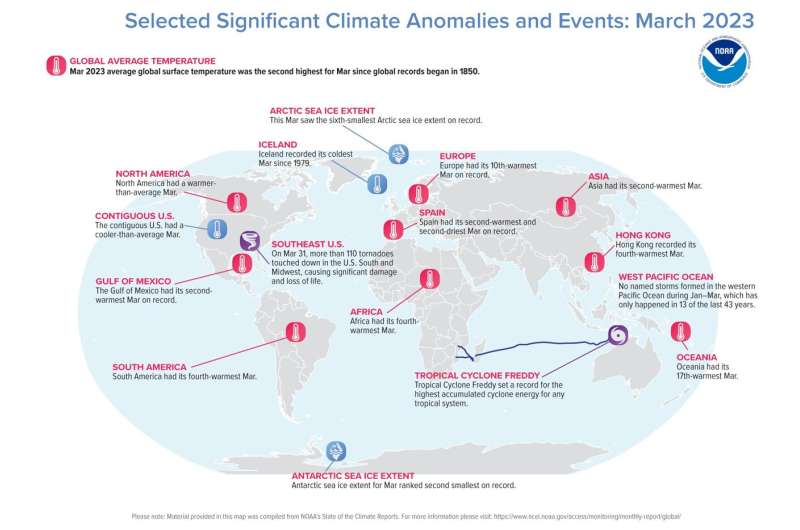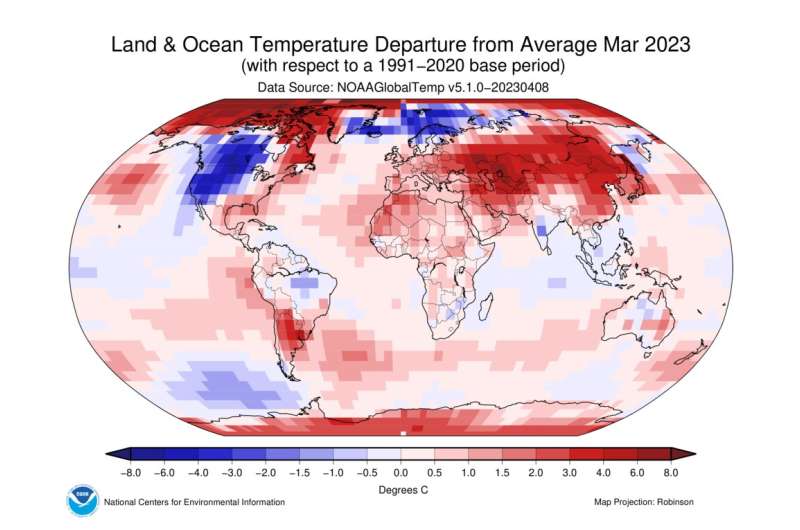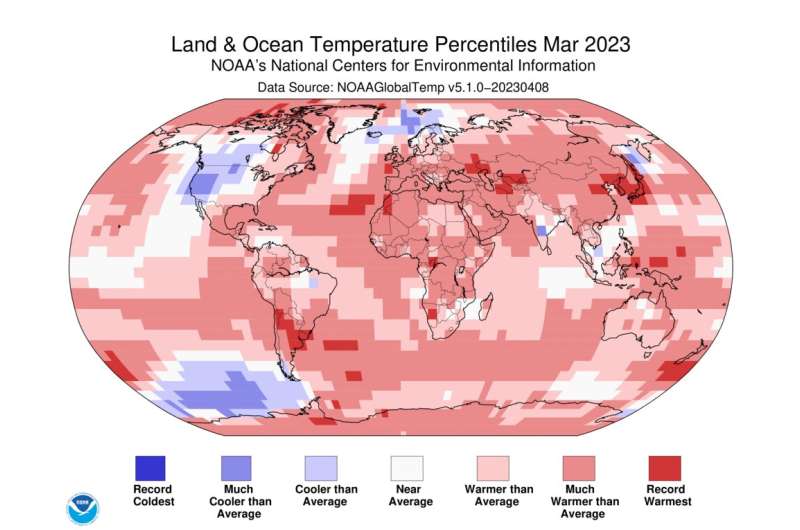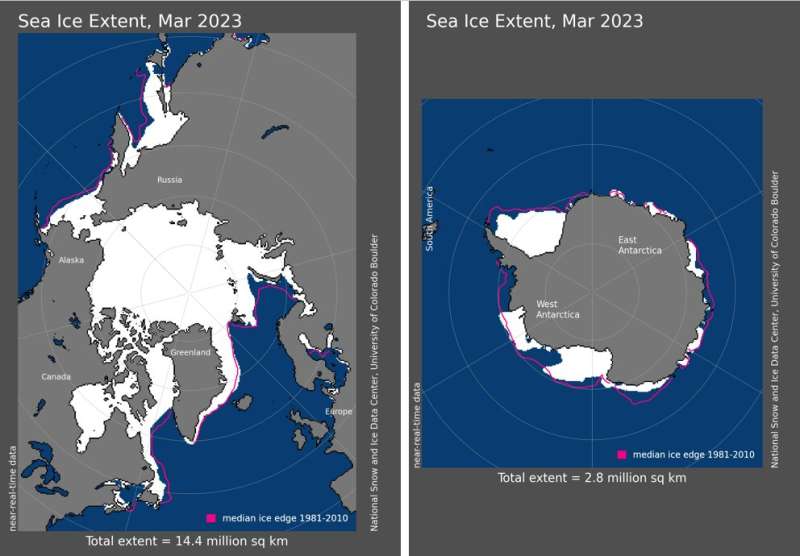This article has been reviewed according to Science X's editorial process and policies. Editors have highlighted the following attributes while ensuring the content's credibility:
fact-checked
trusted source
proofread
Climate report: Earth just had its second-warmest March on record

Globally, March 2023 was the second-warmest March in the 174-year NOAA record. The year-to-date (January–March) global surface temperature was the fourth warmest on record. According to NCEI's Global Annual Temperature Outlook, it is virtually certain (>99.0%) that the year 2023 will rank among the 10-warmest years on record and a 96% chance it will rank among the top five.
This monthly summary, developed by scientists at NOAA's National Centers for Environmental Information, is part of the suite of climate services NOAA provides to government, business, academia and the public to support informed decision-making.
Coinciding with the release of the January 2023 Global Climate Report, the NOAA Global Surface Temperature (NOAAGlobalTemp) dataset version 5.1.0 replaced version 5.0.0. This new version includes complete global coverage and an extension of the data record back in time an additional 30 years to January 1850. While anomalies and ranks might differ slightly from what was reported previously, the main conclusions regarding global climate change are very similar to the previous version. Please NOAA's Commonly Asked Questions Document and web story for additional information.
Monthly global temperature
The March global surface temperature was 2.23°F (1.24°C) above the 20th-century average of 54.9°F (12.7°C). Last month ranks as the second-warmest March in the 174-year record after 2016. March 2023 marked the 47th-consecutive March and the 529th-consecutive month with temperatures at least nominally above the 20th-century average. On March 9, NOAA's Climate Prediction Center announced the end of the three-year La Niña, as well as a return to neutral El Niño Southern Oscillation (ENSO-neutral) conditions likely through Northern Hemisphere spring and early summer 2023.

Asia had its second-warmest March on record at 7.34°F (4.08°C) above average. South America and Africa each had their fourth-warmest March, while Europe had its 10th-warmest March on record. Oceania recorded its 17th-warmest March, and while North America had a warmer-than-average March, it did not rank among the top-20 warmest on record.
Temperatures were above average throughout most of Asia, Africa, South America and Antarctica. Parts of eastern North America, Europe, the Arctic and Oceania also experienced warmer-than-average temperatures this month. Land temperatures in the Southern Hemisphere ranked warmest on record for the month. Sea surface temperatures were above average across much of the northern, western and southwestern Pacific, the central and southern Atlantic and the western and southern Indian Ocean. Record warm temperatures covered just over 4% of the world's surface this month.

Temperatures were near to cooler than average across much of western and central North America, Iceland and across parts of southeastern Greenland and northern Europe including Scandinavia. Sea surface temperatures were near to below average over parts of the eastern North Atlantic and the southeastern and central tropical Pacific. Less than 1% of the world's surface had a record-cold March.
Sea ice and snow cover
Globally, March 2023 saw the second-smallest March sea ice extent on record.
Arctic sea ice extent in March averaged 5.58 million square miles, which was about 230,000 square miles below the 1991–2020 average. This marks the sixth-smallest March extent in the 45-year record. According to the National Snow and Ice Data Center, Arctic sea ice likely reached its maximum extent for the year on March 6 at 5.64 million square miles, which ranks as the fifth-lowest Arctic maximum in the 45-year satellite record. Meanwhile, the March 2023 Antarctic sea ice extent ranked second lowest on record at 1.08 million square miles, or about 490,000 square miles below the 1991–2020 average.

According to data from NOAA and analysis by the Rutgers Global Snow Lab, the Northern Hemisphere snow cover extent during March was 200,000 square miles below the 1991–2020 average. This ranks as the 15th-smallest Northern Hemisphere snow cover extent on record. Extent was above average in North America and Greenland, which tied 1971 as the fourth-largest extent on record. Meanwhile, Eurasia recorded its sixth-smallest March snow cover extent on record.
Global precipitation
Above-average March precipitation was observed across parts of the western U.S., northern and eastern Europe and northern Asia. Meanwhile, drier-than-average conditions were present across much of southern Alaska, the eastern U.S., southern Europe, northern Africa and eastern China.
Global tropical cyclones
Four named storms occurred across the globe in March. All four reached tropical cyclone strength (winds ≥74 mph), and three of those named storms reached major tropical cyclone strength (winds ≥111 mph). Although the number of storms was less than average, the numbers that reached tropical and major tropical cyclone strength were both higher than the March average. The exceptionally long-lived Tropical Cyclone Freddy in the South Indian Ocean set a record for the largest amount of accumulated cyclone energy (ACE), an integrated metric of the strength, frequency and duration of tropical storms, for any storm on record.
More information: March 2023 Global Climate Report: www.ncei.noaa.gov/access/monit … report/global/202303
Provided by NOAA Headquarters





















